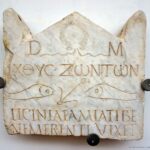We associate royal insignia primarily with the kings of medieval and modern Europe. But have you ever wondered what the insignia of imperial power might have looked like in Rome?
Roman emperors did not wear crowns. But many bas-reliefs and gems contain images of emperors with scepters. A dozen or so years ago, during excavations at the foot of the Roman Palatine Hill (from the Colosseum side), an extraordinary treasure was discovered – scepters and ceremonial spears hidden in the ruins of the Curiae Veteres sanctuary. The discovery was fascinating for two reasons:
First of all, previously the appearance of such objects was known only from iconography. Now, archaeologists finally had the opportunity to see such objects with their own eyes. Their character, noble materials from which they were made, and craftsmanship precision left no doubt that it was a symbol of power: civil and military. These objects were immediately associated with those accompanying rulers on ancient gems. Here are the symbols of imperial power found!
But the second thing that immediately caught the attention of researchers were the circumstances that allowed the discovered monuments to survive for so many centuries. The details of the discovery suggested that the imperial insignia were not found there by accident. On the contrary, they showed that someone had deliberately wrapped valuable items and carefully hidden them in an inaccessible place in the old sanctuary, and the hiding place was quickly forgotten. Examination of archaeological layers showed that it must have occurred at the earliest at the end of the 3rd century AD, and at the latest at the beginning of the 4th century CE.
This led archaeologists and historians to a fascinating clue that these may be the insignia of Emperor Maxentius. Let us recall that the beginning of the 4th century was a turbulent period in the history of Rome, and the reign of Maxentius was interrupted by a lost civil war with Constantine, who eventually became the new emperor. Before this happened, however, the troops of Maxentius, who ruled the capital, clashed with the army of Constantine near Rome (the so-called Battle of the Milvian Bridge). As a result of the battle, Maxentius died in the waters of the Tiber, and Constantine took power.
Although there is no direct hard evidence for this, it is possible that one of Maxentius’s officers, seeing the death of his commander, rode on horseback to Rome, carrying with him valuable insignia of power so that they would not fall into the hands of the victorious Constantine. His imagination suggests a vision of him hiding them under the cover of darkness in a secret hiding place near the Colosseum. What happened next? Nobody knows. Constantine did not find the treasure, which had lain quietly in a hiding place, untouched until today. Perhaps whoever hid the imperial insignia died in the political turmoil that accompanied the change of power? One thing is certain – whoever did it took their secret to the grave for seventeen centuries.
Let’s take a moment to look at the treasure: it consists of three scepters ending with balls made of glass or a cryptocrystalline variety of quartz – chalcedony, and eight carefully made spears and lances to which pennants were attached. Of course, wooden elements and fabrics have not survived to this day, but metal, glass and stone elements have been perfectly preserved. The entire find can be seen in the Palazzo Massimo Alle Terme museum in Rome, on level minus one, where a separate room has been set up for it. I encourage you: every enthusiast of ancient Rome should see them!







